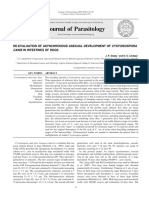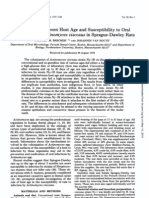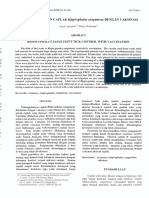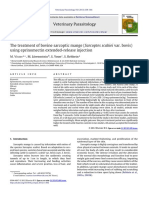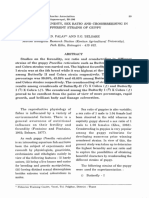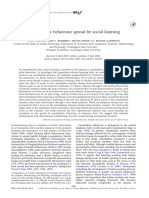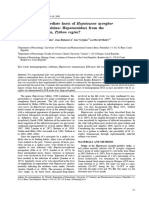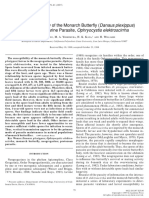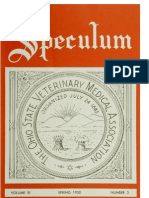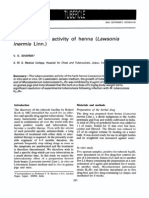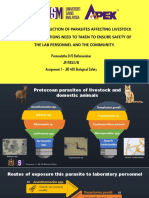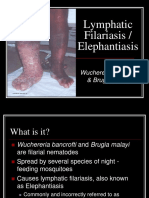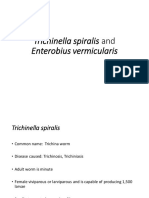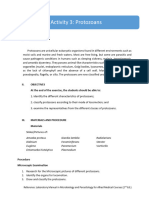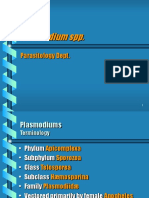The American Society of Parasitologists
The American Society of Parasitologists
Uploaded by
angelCopyright:
Available Formats
The American Society of Parasitologists
The American Society of Parasitologists
Uploaded by
angelOriginal Title
Copyright
Available Formats
Share this document
Did you find this document useful?
Is this content inappropriate?
Copyright:
Available Formats
The American Society of Parasitologists
The American Society of Parasitologists
Uploaded by
angelCopyright:
Available Formats
Infectivity of the Newborn Larva of Trichinella spiralis in the Rat
Author(s): David T. Dennis, Dickson D. Despommier and Norma Davis
Source: The Journal of Parasitology, Vol. 56, No. 5 (Oct., 1970), pp. 974-977
Published by: The American Society of Parasitologists
Stable URL: http://www.jstor.org/stable/3277516 .
Accessed: 02/08/2014 06:06
Your use of the JSTOR archive indicates your acceptance of the Terms & Conditions of Use, available at .
http://www.jstor.org/page/info/about/policies/terms.jsp
.
JSTOR is a not-for-profit service that helps scholars, researchers, and students discover, use, and build upon a wide range of
content in a trusted digital archive. We use information technology and tools to increase productivity and facilitate new forms
of scholarship. For more information about JSTOR, please contact support@jstor.org.
The American Society of Parasitologists is collaborating with JSTOR to digitize, preserve and extend access to
The Journal of Parasitology.
http://www.jstor.org
This content downloaded from 193.85.227.26 on Sat, 2 Aug 2014 06:06:12 AM
All use subject to JSTOR Terms and Conditions
THE JOURNAL OF PARASITOLOGY
Vol. 56, No. 5, October 1970, p. 974-977
INFECTIVITY
OF THE NEWBORNLARVA
OF TRICHINELLA
SPIRALISIN THE RAT*
David T. Dennis,t t Dickson D. Despommier,and Norma Davis
Tropical Disease Unit, Cornell University Medical College, New York, New York 10021
ABSTRACT: A method is described for the isolation of large numbers of newborn larvae from adult
Trichinella spiralis. These isolated larvae were used in experimentswhich tested their ability to infect
mice via the intraduodenal, intravenous, and intraperitonealroutes, and to infect rats via the intraperi-
toneal and intravenous routes. Encysted muscle larvae were seen in diaphragmpreparationsfrom mice
injected intravenously and intraperitoneally 14 days previously with newborn larvae. No muscle larvae
were seen in diaphragm muscle preparationsfrom mice which had received newborn larvae intraduo-
denally. Quantitative studies on larval infectivity were carried out in rats. Larval counts showed that
66% of the larvae were recoverableas mature muscle larvae from rats injected iv, while only 2% of the
original dose was recovered from ip injected rats. In another experiment using larger numbers of rats
in each group, newborn larvae were 73% infective in iv injected rats, and only 9% infective in ip
injected rats. Nembutal, administered ip to rats prior to infection with newborn larvae, had no major
effect on larval infectivity.
Limited numbers of newborn larvae have ogenicity, and immunogenicity of the newborn
been isolated from host body cavities (Matoff, larva of T. spiralis are still lacking.
1940; Berntzen, 1965; Shanta and Meerovitch, We describe here a reproducible system for
1967) and blood (Matoff, 1943b; Gould et al., obtaining newborn larvae of a known age in
1955; Phillipson and Kershaw, 1961) during large numbers. Isolation techniques are de-
early phases of intestinal infection and have scribed, and a quantitative comparison is made
been described in morphological detail (Richels, of the infectivity of pure preparations of larvae
1955; Ali Khan, 1966). Denham (1967) col- inoculated into rats via the intraperitoneal and
lected parenterally infective newborn larvae intravenous routes. We show that both mice
after incubation of gravid females for 24 to 48 and rats can be infected with this stage via the
hr. However, isolation of large numbers of ip and iv routes and that the newborn larvae
newborn larvae of a determinable age has not are more infective for the rat when they are
previously been described, although Larsh inoculated iv as opposed to ip.
(1963) and others have suggested that this
would be necessary in order to better correlate AND METHODS
MATERIALS
the stage of the parasite with host immunity. Mature muscle larvae were obtained from stock-
Inoculation of gravid female worms and new- infected CFW male mice by the method of Larsh
born larvae of Trichinella spiralis demonstrated and Kent (1949). Male Wistar rats (120 g) were
inoculated orally with approximately10,000 muscle
that newborn larvae could infect dogs and rats larvae suspended in a mixture of 0.6% nutrient
by the parenteral route (Matoff, 1943a). How- broth and 2% gelatin with the aid of a syringe
fitted with a blunt 18-gauge needle. We removed
ever, quantitative data about infectivity, path- the food from the rats on the 6th day postinfection
and killed them on the 7th. The entire small in-
Received for publication 3 February 1970. testine was then removed from each animal, slit
longitudinally, cut into 2-cm sections, and placed
t The RockefellerUniversity, New York,New York in a modified Baermann apparatus containing
10021. 0.85% saline solution at 37 C. Adult worms were
+tPlease addressreprintrequests to author Dickson collected over a period of 4 hr, and resedimented
D. Despommier. in flasks, then washed 4 times at intervals of 0.5
* This work was supported, in part, by USPHS hr with saline at 37 C. Worms thus treated ap-
Training Grant F02-A-142057, USPHS Grant peared free of debris and were viable. The worms
AI-04842, and NIH Post-Doctoral Fellowship 1- were then transferred to a large, glass moisture
F2-AI--31, 188. chamber containing 300 cc of the following me-
974
This content downloaded from 193.85.227.26 on Sat, 2 Aug 2014 06:06:12 AM
All use subject to JSTOR Terms and Conditions
DENNIS ET AL.-INFECTIVITYOF NEWBORN TRICHINELLA
LARVAIN RAT 975
TABLE I. Iv and ip injection of anesthetized rats TABLE II. Iv and ip injection of nonanesthetized
with newborn larvae. rats with newborn larvae.
Muscle larvae Muscle larvae
recovered per recovered per
animal at animal at
No. Route of day 25 No. Route of day 33
rats* inoculation postinfection SE % infectivity rats* inoculation postinfection SE % infectivity
4 ip 190 4- 52 2 9 ip 330 ? 78 9
5 iv 6,600 ? 980 66 9 iv 2,500 - 256 73
* Each rat received 10,000 (SE = + 550) newborn larvae. * Each rat received 3,400 (SE = ? 180) newborn larvae.
dium: "Medium 199 with Sodium Bicarbonate" ulation. On the 14th day, the mice that re-
(Microbiological Associates, Baltimore, Md.) mained alive-six of the intraduodenally in-
(70% by volume), "Dialyzed Calf Serum" (Micro- fected group, seven of the intravenous, and two
biological Associates, Baltimore, Md.) (29% by
volume), and "Antibiotic-Antimycotic Mixture" of the intraperitoneal-were killed, and speci-
(Grand Island Biol. Co.) (1% by volume). The mens of diaphragm muscle were pressed be-
worms were then incubated for 16 to 20 hr at 37 C tween glass slides and examined for the pres-
and during this time larvae were shed.
ence of muscle larvae. Infective larvae were
The medium containing adults and larvae was
then passed through 3 layers of thin wire mesh, seen in diaphragms of iv and ip injected mice.
each with a 25-/, pore size (George A. Williams & No larvae were found in any musculature of
Son, New York, N. Y.). The adult-free larvae in mice injected intraduodenally, as determined
the filtrate were then sedimented for 5 min at
225 g at room temperaturein 50-cc conical centri- by muscle presses of representative samples
fuge tubes, pooled, washed in warm saline, and of skeletal muscle.
resedimented at the same speed. The supernatant In the next experiments we used rats, which
was removed and the worms resuspended in ap- proved to be hardier, and therefore more re-
proximately 30 ml of saline. Samples of 0.075 ml liable, experimental animals than mice.
were spread on glass slides and larvae were counted
under the microscope until 3 consecutive counts Experiment 2a. Parenteral infection of
varied by no more than 10. Only motile larvae anesthetized rats with newborn larvae
were counted. Quantities of suspension containing
the desired numbers of larvae were withdrawn for Nine male Wistar rats (120 g) were anesthe-
inoculation while the fluid was being agitated by tized ip with Nembutal (0.51 mg/10 g body
a magnetic stirring device. Ninety-eight per cent weight). Four rats each received an average of
of the larvae were motile just prior to inoculation.
10,000 (SE = - 550) larvae ip and five rats
RESULTS were each inoculated iv with a similar dose of
Preliminary studies demonstrated that viable newborn larvae. All rats survived, and were
newborn larvae can be isolated in large num- killed 25 days after infection. Muscle larvae
bers by in vitro maintenance of gravid female from the entire carcass of each rat were isolated
worms for 16 to 20 hr. Each female produced by peptic digestion, and counted by standard
an average of 10 newborn larvae during this techniques (Larsh and Kent, 1949). The re-
time. sults, presented in Table I, show that newborn
larvae were more infective by the iv route
Experiment 1. Enteral and parental infection of
mice with newborn larvae (66%) than by the ip route (2%).
In a preliminary study, 27 CFW male mice Experiment 2b. Parenteral infection of
were anesthetized ip with Nembutal (0.51 mg/ nonanesthetized rats with newborn larvae
10 g body weight). Eight mice were laparoto- In order to test the possibility that low infec-
mized and each was inoculated with 2,600 tivity of newborn larvae injected ip was due to
(SE = + 150) newborn larvae intraduodenally. interference by Nembutal, nonanesthetized rats
A second group of 13 mice each received the were used in the next experiment.
same dose of newborn larvae via the dorsal tail Nine rats each received an estimated 3,400
vein. Each of a third group of six mice was (SE = ? 180) newborn larvae ip and nine
inoculated intraperitoneally with a similar dose others were each infected iv with a similar dose.
of newborn larvae. A large number (44%) of All rats survived, and muscle larvae were re-
the mice died during the first 4 days after inoc- covered by peptic digestion of the entire car-
This content downloaded from 193.85.227.26 on Sat, 2 Aug 2014 06:06:12 AM
All use subject to JSTOR Terms and Conditions
976 THEJOURNALOF PARASITOLOGY,
VOL. 56, NO. 5, OCTOBER1970
cass of each rat 33 days after infection. The eluded that the primary method of dissemina-
7% difference between the larval counts from tion was a passive one in the blood and lymph.
the anesthetized and unanesthetized rats was In support of this conclusion he cited previous
not statistically significant. The results in Table work in which he had demonstrated muscle
II show that Nembutal had no major effect on larvae in rats and dogs after intravenous inocu-
the infectivity of newborn larvae when given lation of gravid female trichinella, and had
ip. A 73% recovery of muscle larvae was ob- isolated larvae from portal venous blood, mes-
tained for the iv injected group as compared enteric lymph nodes, and the thoracic ducts of
to a 9% recovery of muscle larvae for the ip animals with active intestinal infection.
injected rats. These data confirm the results The results of our studies confirm previous
obtained in Experiment 2a. In both experi- reports of infectivity of newborn larvae by ip
ments 2a and 2b a significant difference (P > and iv parenteral routes. Furthermore, the
0.001) was found between larval counts from percentage of muscle larvae developing from
rats inoculated ip and those which received known numbers of inoculated newborn larvae
newborn larvae iv. was also determined. The significant difference
noted between the intravenous and intraperi-
DISCUSSION toneal routes of injections supports the "pas-
A reproducible system of experimental infec- sive" migration hypothesis. It is possible that
tion with known numbers of newborn larvae of conditions in vitro may have selectively inhib-
a known age is necessary in order to obtain ited the infectivity of the larvae injected intra-
precise data on newborn larval infectivity, de- peritoneally. However, this seems unlikely,
velopment, and immunogenicity. Such a sys- since larvae from the same culture as those
tem, permitting isolation of large numbers of injected ip were able to penetrate capillary
newborn larvae, has now been developed. walls and muscle with a high degree of effi-
Newborn larvae were consistently infective ciency when inoculated iv.
when injected iv (66% in Experiment 2a and
73% in Experiment 2b). Since not more than ACKNOWLEDGMENTS
1 to 2% of the newborn larvae were nonmotile The authors acknowledge with gratitude the
at the time of inoculation, and since the stan- encouragement and support of Drs. B. H. Kean
dard error for the newborn larval counts did and G. J. Jackson. We especially wish to thank
not exceed 5%, tho loss of infectivity (about Dr. A. A. Held for his most helpful criticisms of
25 to 35%) observed in the iv injected rats re- this manuscript.
mains to be explained. Since larvae are born
from the mother live and sequentially, it is pos- LITERATURECITED
sible that either the most developed or the ALI KHAN, Z. 1966. The post embryonic devel-
least developed larvae are the ones affected opment of Trichinella spiralis with special
most by the in vitro conditions. reference to ecdysis. J. Parasit. 52: 248-259.
BERNTZEN, A. K. 1965. Comparativegrowth and
Intravenous and intraperitoneal inoculation
development of Trichinella spiralis in vitro
routes were chosen in order to test which route and in vivo, with a redescription of the life
might be favored by larvae during infection. cycle. Exp. Parasit. 16: 74-106.
The question of the route of infection by larvae DENHANM, D. A. 1967. Applications of the in
in the host has a long history of controversy, vitro culture of nematodes, especially Trichi-
the basic question being whether or not the nella spiralis. In Problemsof In Vitro Culture.
Symp. Br. Soc. Parasit. No. 5. Blackwell Sci-
primary avenue of migration from the intestine entific Publications, Oxford and Edinburgh,
to striated muscle is via the blood and lym-
p. 49-60.
phatic channels or by direct passage through GOULD, S. E., J. J. GOMBERG, F. H. BETHELL, J. B.
the intestinal wall, peritoneum, and connective VILLELLA, AND C. S. HERTZ. 1955. Studies
tissues. The controversy was renewed by on Trichinella spiralis. II. Time of initial re-
recent findings of Berntzen (loc. cit.) and covery of larvae of Trichinella spiralis from
blood of experimental animals. Am. J. Path.
Shanta and Meerovitch (loc. cit.) which added
31: 936-942.
to the latter hypothesis. The subject was ex- LARSH,J. E., JR. 1963. Experimentaltrichiniasis.
tensively reviewed by Matoff (1967), who con- Adv. Parasit. I: 213-286.
This content downloaded from 193.85.227.26 on Sat, 2 Aug 2014 06:06:12 AM
All use subject to JSTOR Terms and Conditions
DENNISETAL.-INFECTIVITY TRICHINELLA
OF NEWBORN LARVA
IN RAT 977
, AND D. E. KENT. 1949. The effect of young trichinellae in the host organism. Zbl.
alcohol on natural and acquired immunity of Bakt. 208: 386-419.
mice to infection with Trichinella spiralis. J. PHILLIPSON,R. F., AND W. E. KERSHAW. 1961.
Parasit. 35: 45-53. The production, deposition and growth of the
MATOFF, K. 1940. Untersuchungen fiber den larvae of Trichinella spiralis, and the signifi-
Wanderungswegder Jungtrichinellenim Wirt- cance in chemotherapy of the infection. II.
skorper. Ztschr. Inf. Parasit. Krankh. Hyg. Production and deposition of larvae. Ann.
Haustiere. 56: 237-256. Trop. Med. Parasit. 55: 231-234.
1943a. Age conditioned immunity in RICHELS,I. 1955. Histologische Studien zu den
Problem der Zellkonstanz: Untersuchungen
dogs and parenterally produced muscular zur mikroskopischenAnatomie im Lebenszyk-
trichinellosis. Zbl. Bakt. Orig. 150: 328-336. lus von Trichinella spiralis. Zbl. Bakt. I.
1943b. Uber die Verbreitungder Jung- Orig. 63: 46-84.
trichinellen durch die Vena Portae. Ztschr. SHANTA,C. S., AND E. MEEROVITCH. 1967. The
Inf. Parasit.Krankh.Hyg. Haustiere.60: 113- life cycle of Trichinellaspiralis. II. The muscle
142. phase of development and its possible evolu-
. 1967. The routes of distribution of tion. Can. J. Zool. 45: 1261-1267.
RESEARCH NOTE . . .
Porocephaluscrotali (Pentastomida)in South Carolina
During 1968 seven crotaline snakes from one to 14 nymphs per host. Sigmodon hispi-
South Carolina were examined for endopara- dus has been reported previously as an inter-
sites. Adult forms of Porocephalus crotali mediate host of P. crotali (Layne, 1967, Bull.
(Humboldt, 1808) were found in the lungs of Wildl. Dis. As. 3: 105-109), but this is the first
four of five eastern cottonmouths (Agkistrodon report of nymphs in Oryzomys palustris. Al-
p. piscivorus) and in two eastern diamondback though infections in M. musculus have been
rattlesnakes (Crotalus adamanteus) from two documented by Stiles and Hassall (1894, Vet.
counties (Colleton and Jasper) in the coastal Mag. 1: 245-253; 331-354) and Esslinger
plain region of the state. Numbers of parasites (1962, J. Parasit. 48: 452-456), these were
per snake varied from one to two for the cot- experimentally established. The present find-
tonmouths and from three to five for the rat- ing, therefore, constitutes the first record of a
tlesnakes. Eastern diamondback rattlesnakes natural infection in a feral house mouse. Layne
and cottonmouths have been reported as hosts (op. cit.) examined 328 Al. musculus and 32
of P. crotali in Florida and Louisiana (Brues, 0. palustris from several areas in Florida, but
1942, Ohio J. Sci. 42: 112; Penn, 1942, J. none were infected. However, he did find
Parasit. 28: 277-283), but this is the first nymphs in other rodents (Peromyscus flori-
record of this parasite in South Carolina. danus, P. gossypinus, and S. hispidus) taken
from the same regions.
A series of 187 rodents from Bear Island,
Colleton County, where two of the infected
Donald J. Forrester,* Robert M. Shealy, and
cottonmouths were collected, was examined for Stephen H. Best, Department of Entomology and
nymphs of P. crotali. One of 89 feral Mus Zoology, Clemson University, Clemson, South Car-
olina 29631 (*Present address: Division of Bio-
musculus, one of 81 Sigmodon hispidus, and
logical Sciences, University of Florida, Gainesville,
three of 17 Oryzomys palustris contained from Florida 32601.)
This content downloaded from 193.85.227.26 on Sat, 2 Aug 2014 06:06:12 AM
All use subject to JSTOR Terms and Conditions
You might also like
- Lee 1975Document11 pagesLee 1975RichardDavidNo ratings yet
- Punctata (Mulsant) (Coleoptera: Coccinellidae) : Life History and Feeding Behaviour of Coccinellid Predator, CalviaDocument4 pagesPunctata (Mulsant) (Coleoptera: Coccinellidae) : Life History and Feeding Behaviour of Coccinellid Predator, CalviaPRABHAT KUMAR CHAUHANNo ratings yet
- Survival of Rabbit Haemorrhagic Disease Virus (RHDV) in The EnvironmentDocument12 pagesSurvival of Rabbit Haemorrhagic Disease Virus (RHDV) in The EnvironmentrmkamundimuNo ratings yet
- The Life Cycle of The Nematode Caenorhabditis ElegansDocument11 pagesThe Life Cycle of The Nematode Caenorhabditis ElegansMakoto EnokiNo ratings yet
- Ef7f1ea7 5d56 40af Ac3e 4adad1a1efd8Document3 pagesEf7f1ea7 5d56 40af Ac3e 4adad1a1efd8Xime PlascenciaNo ratings yet
- Delivery of Duvernoy's SecretionDocument7 pagesDelivery of Duvernoy's SecretionYohanes Pandhu WilantoroNo ratings yet
- Trans R Soc Trop Med Hyg-1952-Dick-509-20Document12 pagesTrans R Soc Trop Med Hyg-1952-Dick-509-20Julio MartinNo ratings yet
- Journal of Parasitology CystoisosporaDocument5 pagesJournal of Parasitology Cystoisosporaangelica hernandezNo ratings yet
- Sva,+altex 1996 2 76 87 KuhnertDocument12 pagesSva,+altex 1996 2 76 87 KuhnertAlexander SalvadorNo ratings yet
- Mitsuda Reaction in Armadillos Dasypus Derived Antigens: Novemcinctus Using Human and ArmadilloDocument5 pagesMitsuda Reaction in Armadillos Dasypus Derived Antigens: Novemcinctus Using Human and ArmadilloTelenrico MatemáticoNo ratings yet
- Relationship Colonization: Between byDocument9 pagesRelationship Colonization: Between byAhmad Faheem QureshiNo ratings yet
- Journal ResearchDocument4 pagesJournal ResearchFaizaSenjaWidyaPerdanaNo ratings yet
- In Vitro Cultivation of Fasciola He'Patica Metacercariae and of Partially Developed Flukes Recovered From MiceDocument7 pagesIn Vitro Cultivation of Fasciola He'Patica Metacercariae and of Partially Developed Flukes Recovered From MiceGuisela Huamanta AguilarNo ratings yet
- 1979 - Francke - Observations On The Reproductive Biology and Life History of Mega Corm Us Gertschi Diaz Scorpiones Chactidae MegacorminaeDocument8 pages1979 - Francke - Observations On The Reproductive Biology and Life History of Mega Corm Us Gertschi Diaz Scorpiones Chactidae MegacorminaeadriendrixNo ratings yet
- Study of The Role of Pigeons in The Dissemination of Cryptococcus Neoformans in NatureDocument6 pagesStudy of The Role of Pigeons in The Dissemination of Cryptococcus Neoformans in NatureTANIA CORONADO ROMERONo ratings yet
- 159 FullDocument19 pages159 FullMina BekNo ratings yet
- Enders 1954 - Propagation-In-Tissue-Cultures-Of-Cytopathogenic-Agents-From-Patients-With-MeaslesDocument10 pagesEnders 1954 - Propagation-In-Tissue-Cultures-Of-Cytopathogenic-Agents-From-Patients-With-MeaslesRoger TNo ratings yet
- Morgan 1975 Trabajo Pionero SpalangiaDocument2 pagesMorgan 1975 Trabajo Pionero SpalangiajuanNo ratings yet
- William C. Campbell, Robert K. Hartman, and Ashton C. CucklerDocument6 pagesWilliam C. Campbell, Robert K. Hartman, and Ashton C. CucklerRezita RamadhaniNo ratings yet
- Baba T.1984. Cell-Mediated Immune Protection in Chickens Against P MultocidaDocument6 pagesBaba T.1984. Cell-Mediated Immune Protection in Chickens Against P MultocidakrodriguezNo ratings yet
- The Treatment of Bovine Sarcoptic Mange (Sarcoptes Scabiei Var. Bovis) Using Eprinomectin Extended-Release InjectionDocument6 pagesThe Treatment of Bovine Sarcoptic Mange (Sarcoptes Scabiei Var. Bovis) Using Eprinomectin Extended-Release InjectionNatalia RodriguezNo ratings yet
- Estudo Taurina Longevidade Science - Abn9257 - SMDocument42 pagesEstudo Taurina Longevidade Science - Abn9257 - SMNicole SimonatoNo ratings yet
- Comparison of The Pathogenicity Among Cronobacter Species in A Neonatal Mouse ModelDocument5 pagesComparison of The Pathogenicity Among Cronobacter Species in A Neonatal Mouse Modellibrary2540No ratings yet
- From The Hospital of The Rockefeller Institute For Medical ResearchDocument6 pagesFrom The Hospital of The Rockefeller Institute For Medical ResearchJhonson De Carl SitepuNo ratings yet
- Schistosoma Haematobium Infection Opossum (Dideiphis Marsupialis) : Involvement Urogenital SystemDocument9 pagesSchistosoma Haematobium Infection Opossum (Dideiphis Marsupialis) : Involvement Urogenital SystemKhafizasaniaNo ratings yet
- Collection and Cryopreservation of Preimplantation Embryos of Cavia PorcellusDocument6 pagesCollection and Cryopreservation of Preimplantation Embryos of Cavia PorcellusEveAriNo ratings yet
- Cross Guppy Butterfly CobraDocument8 pagesCross Guppy Butterfly CobraAldo MenggilaNo ratings yet
- Novel Proteinaceous Infectious Particles Cause ScrapieDocument10 pagesNovel Proteinaceous Infectious Particles Cause ScrapieMikey HaveyNo ratings yet
- 1986 Odonoghue - The Prevalence and Intensity of SarcocystiS SPP Infections in Sheep IF.1,04 MUY BUENODocument6 pages1986 Odonoghue - The Prevalence and Intensity of SarcocystiS SPP Infections in Sheep IF.1,04 MUY BUENOIgnacio GualNo ratings yet
- Culture-Dependent and Culture-IndependenDocument7 pagesCulture-Dependent and Culture-Independenじょしら フィアンナNo ratings yet
- 1 s2.0 S0003347202930174 MainDocument10 pages1 s2.0 S0003347202930174 Mainandreea.dumitrescuNo ratings yet
- Folia_fol-200801-0003Document4 pagesFolia_fol-200801-0003lucasmonje1978No ratings yet
- Changes in The Aerobic Vaginal Bacterial Mucous Load and Assessment of The Susceptibility To Antibiotics After Treatment With Intravaginal Sponges in Anestrous Ewes PDFDocument5 pagesChanges in The Aerobic Vaginal Bacterial Mucous Load and Assessment of The Susceptibility To Antibiotics After Treatment With Intravaginal Sponges in Anestrous Ewes PDFReynaldo Bazaldúa VCNo ratings yet
- JurnalDocument13 pagesJurnalparkc6922No ratings yet
- Sawadogo Et Al-2017-Parasitology Research-1Document6 pagesSawadogo Et Al-2017-Parasitology Research-1Boureima SAWADOGONo ratings yet
- Ge-1499 1Document7 pagesGe-1499 1ayakashimajorinNo ratings yet
- Leong 1997Document5 pagesLeong 1997Gustavo ZaRoNo ratings yet
- Show Me Your Fucking Girlbutt (Asshole)Document9 pagesShow Me Your Fucking Girlbutt (Asshole)Restroom ChemistryNo ratings yet
- SPECULUM v03 I03 1950Document8 pagesSPECULUM v03 I03 1950DaniMaenNo ratings yet
- Reproductive Aspects of Haemaphysalis Leporis-Palustris: Marcelo Bahia Labruna, Romário Cerqueira LeiteDocument4 pagesReproductive Aspects of Haemaphysalis Leporis-Palustris: Marcelo Bahia Labruna, Romário Cerqueira LeiteGlauber MenesesNo ratings yet
- Mendoza Et Al 1993 Life Cycle of The Human and Animal Oomycete Pathogen Pythium InsidiosumDocument7 pagesMendoza Et Al 1993 Life Cycle of The Human and Animal Oomycete Pathogen Pythium InsidiosumMonica MattosNo ratings yet
- RT PCRDocument10 pagesRT PCRHoa LeNo ratings yet
- Tuberculostatic Activity of Henna (LawsoniaDocument3 pagesTuberculostatic Activity of Henna (Lawsonia9884288233No ratings yet
- Effects of Ivermectin On Reproduction and Neonatal Toxicity in Rats G. R. Lankas, D. H. Minskerand R. T. RobertsonDocument7 pagesEffects of Ivermectin On Reproduction and Neonatal Toxicity in Rats G. R. Lankas, D. H. Minskerand R. T. RobertsonaftermathaftermathNo ratings yet
- Tugas Paper 1Document2 pagesTugas Paper 1Dini SamjayaNo ratings yet
- Successful Treatment of Trypanoxyuris Sp. Infection in Naturally Infected Southern Brown-Howlers (Alouatta Guariba Clamitans)Document6 pagesSuccessful Treatment of Trypanoxyuris Sp. Infection in Naturally Infected Southern Brown-Howlers (Alouatta Guariba Clamitans)cadastrinhosaninhaNo ratings yet
- Biological efficacy of Metarrhizium anisopliae and Entomophothra-PRINTEDDocument7 pagesBiological efficacy of Metarrhizium anisopliae and Entomophothra-PRINTEDNg Kin HoongNo ratings yet
- Cimex Lectularius Como Vector de T CruziDocument9 pagesCimex Lectularius Como Vector de T Cruzianaibeth nessiNo ratings yet
- Further Studies On T H E Destructive Effect The Virus Russian Far East Encepha-Litis O N T H E Transplantable Mouse SarcomaDocument5 pagesFurther Studies On T H E Destructive Effect The Virus Russian Far East Encepha-Litis O N T H E Transplantable Mouse SarcomacthjgfytvfnoNo ratings yet
- S Chilli Ger 2013Document7 pagesS Chilli Ger 2013Gergő VidovicsNo ratings yet
- Roth Et Al. - 1988 - Predation by The Introduced Phoretic Mite, MacrochDocument5 pagesRoth Et Al. - 1988 - Predation by The Introduced Phoretic Mite, MacrochJuan UrrutiaNo ratings yet
- 2007-Prevalence and Molecular Characterization of Cryptosporidium and Giardia Species and Genotypes in Sheep in MarylandDocument8 pages2007-Prevalence and Molecular Characterization of Cryptosporidium and Giardia Species and Genotypes in Sheep in MarylandwiwienNo ratings yet
- Alexandre Specht - Agrotis Malefida - ROUND 1 Revisado Pelo Autor - JEFFDocument22 pagesAlexandre Specht - Agrotis Malefida - ROUND 1 Revisado Pelo Autor - JEFFsamusaran115No ratings yet
- Population and Parity Levels of Aedes Aegypti Collected in TucsonDocument9 pagesPopulation and Parity Levels of Aedes Aegypti Collected in TucsonAnirudh AcharyaNo ratings yet
- T SagiDocument9 pagesT Sagiraija MajriaNo ratings yet
- Different Virulence Levels of The Species of Sporothrix in A Murine ModelDocument5 pagesDifferent Virulence Levels of The Species of Sporothrix in A Murine ModelDany CorrêaNo ratings yet
- Ainmal House 1Document14 pagesAinmal House 1shereensalameh05No ratings yet
- Factors Affecting The Potential Increase Rate (E', PIR), As Defined by Hughes, in Populations of Sitobion Avenae (F.) (Hemiptera: Aphididae)Document5 pagesFactors Affecting The Potential Increase Rate (E', PIR), As Defined by Hughes, in Populations of Sitobion Avenae (F.) (Hemiptera: Aphididae)Νικόλαος ΚυριαζήςNo ratings yet
- Fundamentals of Microbiome Science: How Microbes Shape Animal BiologyFrom EverandFundamentals of Microbiome Science: How Microbes Shape Animal BiologyRating: 3 out of 5 stars3/5 (2)
- Case Analysis: Panpacific University San Vicente, Urdaneta City, Pangasinan College of Nursing S.Y 2020-2021Document5 pagesCase Analysis: Panpacific University San Vicente, Urdaneta City, Pangasinan College of Nursing S.Y 2020-2021Qusai BassamNo ratings yet
- Course Packet 06 Regular Parasite Control ProgramDocument75 pagesCourse Packet 06 Regular Parasite Control ProgramKEVIN MANALONo ratings yet
- 6.ento With Ans DR JADocument4 pages6.ento With Ans DR JAsubramaniam krishnamoorthiNo ratings yet
- Parasitology Collection, Preservation of SpecimensDocument20 pagesParasitology Collection, Preservation of SpecimensSwar KlesNo ratings yet
- 5th Sem Syllabus ZoologyDocument3 pages5th Sem Syllabus ZoologyAdnan BandayNo ratings yet
- Introduction To Medical ParasitologyDocument19 pagesIntroduction To Medical ParasitologyLaila AbdulNo ratings yet
- LiceDocument23 pagesLiceu2004969No ratings yet
- JIB 438 BiosafetyDocument10 pagesJIB 438 BiosafetyvimalaNo ratings yet
- HELMINTOLOGIDocument20 pagesHELMINTOLOGIAnggis KusumaningtyasNo ratings yet
- Kuliah Cestode & Trematode (Hand-Out)Document13 pagesKuliah Cestode & Trematode (Hand-Out)made yogaNo ratings yet
- CHAPTER 1.ppt-2Document49 pagesCHAPTER 1.ppt-2Gemechis MergaNo ratings yet
- Enterobius VermicularisDocument16 pagesEnterobius VermicularisYA MAAPNo ratings yet
- Overview STH Chairil AnwarDocument105 pagesOverview STH Chairil AnwarDry LandNo ratings yet
- course spec 2018 طفيليات معهد فني معاملDocument7 pagescourse spec 2018 طفيليات معهد فني معاملhanan modaNo ratings yet
- Parasitism - The Diversity and Ecology of Animal ParasitesDocument524 pagesParasitism - The Diversity and Ecology of Animal ParasitesRIZKI NANDA100% (1)
- SEd 323 Lesson 1 - Introduction To Microbiology and ParasitologyDocument18 pagesSEd 323 Lesson 1 - Introduction To Microbiology and ParasitologySheilla Mae MacalaladNo ratings yet
- Trichinella Spiralis and Enterobius VermicularisDocument24 pagesTrichinella Spiralis and Enterobius VermicularisJoseph Christian Bielgo CuaNo ratings yet
- Wunchereria Bancrofti: Brugia MalayiDocument6 pagesWunchereria Bancrofti: Brugia MalayiGela Reyes100% (1)
- اسئله مهمه طفيليات نضريDocument11 pagesاسئله مهمه طفيليات نضريxrmd8khg7rNo ratings yet
- Peronema Canescens TERHADAP TINGKAT PERTUMBUHAN Plasmodium BergheiDocument8 pagesPeronema Canescens TERHADAP TINGKAT PERTUMBUHAN Plasmodium BergheiMohamad IrwanNo ratings yet
- Activity 3 ProtozoansDocument6 pagesActivity 3 Protozoansradcliff672No ratings yet
- ACTIVITY NO - 6 - Parasitology - Parasitic HelminthesDocument8 pagesACTIVITY NO - 6 - Parasitology - Parasitic HelminthesMichelle HutamaresNo ratings yet
- Levanthan Short Ans KeyDocument42 pagesLevanthan Short Ans Keyxyab.varga.swuNo ratings yet
- Sporozoa (Plasmodium SPP and Babesia SPP)Document31 pagesSporozoa (Plasmodium SPP and Babesia SPP)the songwriterNo ratings yet
- Plasmodium SPP.: Parasitology DeptDocument38 pagesPlasmodium SPP.: Parasitology DeptDedy SavradinataNo ratings yet
- Para IdentificationDocument14 pagesPara IdentificationMichelle San Miguel FeguroNo ratings yet
- GI Protozoal & Infections Caused by HelminthsDocument39 pagesGI Protozoal & Infections Caused by HelminthsSHIHAB UDDIN KAZINo ratings yet
- Deworming Report Template RevisedDocument26 pagesDeworming Report Template Reviseddal castroNo ratings yet
- Worksheet in Bio 102: Microbiology and Parasitology (WEEK 17)Document3 pagesWorksheet in Bio 102: Microbiology and Parasitology (WEEK 17)DELOS SANTOS JESSIECAHNo ratings yet
- Exercise 11Document2 pagesExercise 11mannuvfran01No ratings yet







